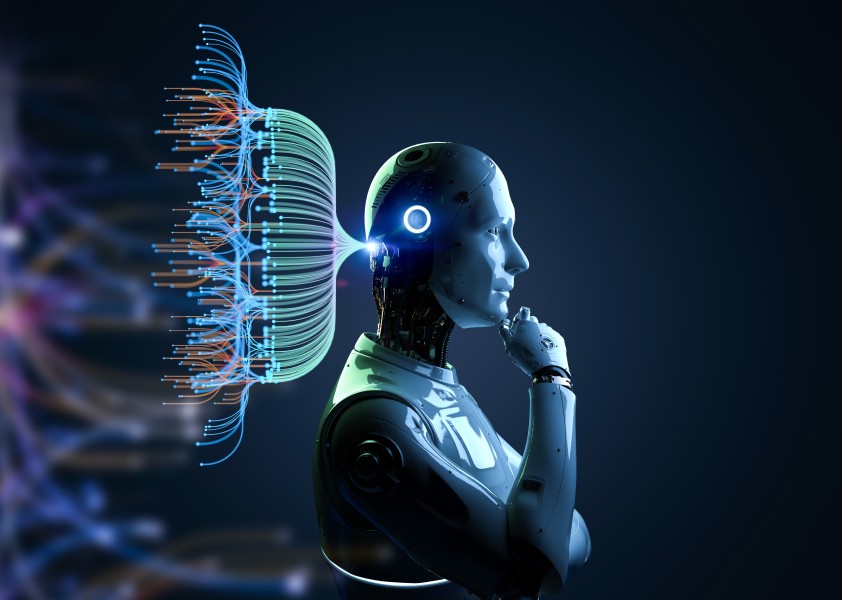
Exploring More About the Types of Artificial Intelligence and How They Work
In this article, we will explore more about the types of Artificial Intelligence (AI) and some real-life examples of their use. To understand the scope and complexity of each of these technological advancements, it’s necessary to use systems that allow them to be grouped according to classification.
I invite you to continue reading to learn more about the types of artificial intelligence and their different classifications.
1. Rule-Based AI
Based on a set of predefined logical rules and formal logic to make decisions and perform specific tasks.
- Solve mathematical calculations or logical instructions.
- Analyze large sets of fast-moving data to identify patterns and potential fraud.
Examples:
Imagine a chatbot as a digital librarian, which methodically organizes and answers inquiries based on a pre-established script. They operate through a defined set of rules and algorithms and respond to user inputs that match certain triggers or keywords. These chatbots are programmed to handle a variety of expected scenarios. For example, if a customer asks about store hours, the chatbot responds with pre-loaded information. However, if the question deviates from the script, the chatbot may fail to understand or respond accurately.

Benefits
Since the rules are clearly defined, these systems are transparent and easy to understand. This makes it easier for programmers to adjust the system and for users to understand the logic behind specific actions.
They work quickly and effectively since they don’t require a lot of data or complex algorithms to function.
They can be highly accurate as long as the rules are well written.
They can be easily updated with new rules, adapting to new situations.
Disadvantages
Limited learning capacity
These systems cannot learn from mistakes or adapt to new situations.
Difficulty with uncertainty
Lack of clear information can cause errors, as precise data is needed for a correct decision.
High maintenance costs
They require continuous maintenance to keep the rules updated.
Difficulty with complex interactions
They can be limited when dealing with interactions that involve multiple rules or inputs.
2. Machine Learning (ML)
In the previous article, I discussed machine learning. To read it again, visit the link:
3. Deep Learning
This type of learning uses artificial neural networks with multiple layers to learn hierarchical representations of data. It is responsible for driving major advancements in areas like image recognition, natural language processing, and voice recognition.
Examples:
Virtual assistants like Alexa or Siri use deep learning to understand human speech and the language used by people when interacting with them.
Benefits
They handle unstructured data well without requiring extensive data preparation.
Neural networks enable deep learning models to understand complex data relationships.
These models are scalable, able to evolve to handle various tasks.
Disadvantages
High computational cost
Training models requires powerful resources such as GPUs, which can be expensive and time-consuming.
Privacy and data security concerns
The use of large data sets raises privacy concerns.
Limited to training data
They can only make predictions based on the data they were trained on.
Overfitting
When a model specializes too much on training data, leading to poor performance on new data.
4. Natural Language Processing (NLP)
According to IBM’s definition, NLP is the field of computer science that enables computers to understand spoken and written language as humans do.
- Morphological: Identifying different words.
- Syntactic: Separating sentences and analyzing their structure.
- Semantic: Understanding the meaning of individual words and sentences.
- Pragmatic: Analyzing the intent behind the text based on its context.
Examples:
Sentiment analysis on social media: NLP systems can identify sentiment in comments about products or services, providing useful information for businesses.
Benefits
- Flexibility: Can process a wide variety of languages.
- Accuracy: Can achieve high accuracy in tasks like text classification and automatic translation.
- Scalability: Can handle large volumes of data.
Disadvantages
Data requirements
Needs large amounts of data for training.
Bias
They may reflect biases present in the training data.
5. Generative AI
Generative AI models are designed to create new content, such as text, audio, images, or videos.
These models work based on machine learning principles, enabling machines to learn from data and then generate new data instances that mimic the properties of the original data.
Generative AI is used to generate design options for graphics and architects, helping them create unique floor plans based on relevant training data.
Benefits
Creativity and innovation: Can create new and original content.
Automation: Can automate content creation, saving time and resources.
Personalization: Can create personalized content based on individual preferences.
Disadvantages
Quality control
The quality of generated content can vary.
Ethical and legal issues
Generative AI can be used to create deepfakes or harmful content.
Dependence
Overreliance on generative AI could lead to a loss of human content creation skills.
AI has the potential to transform organizations. Although AI cannot solve all your organization’s problems, it has the potential to completely change the way business is done, impacting sectors from manufacturing to finance with unprecedented efficiency gains.

Ricardo Oliveira
Head Tech & Innovation
Author
FAQ
Rule-Based AI uses predefined logic and rules to make decisions and solve tasks. It is fast, efficient, and easy to understand but lacks learning capabilities.
Deep Learning uses artificial neural networks to process complex data, like speech and images, enabling advancements in virtual assistants and speech recognition.
Generative AI creates new content like text, audio, or images. It offers creativity, automation, and personalization, but may raise ethical concerns.
Dialogi AI
Find out how our solutions with empat. AI can revolutionize customer service in your business.
Recent Post
- All Posts
- Customer Experience
- Design and Communication
- Ethics and Society
- Evolution and Impact of AI
Categories
Tags
Dialogi | AI | Human-Machine Interaction | Virtual Assistants | Automation | Future of Technology | Digital Communication



